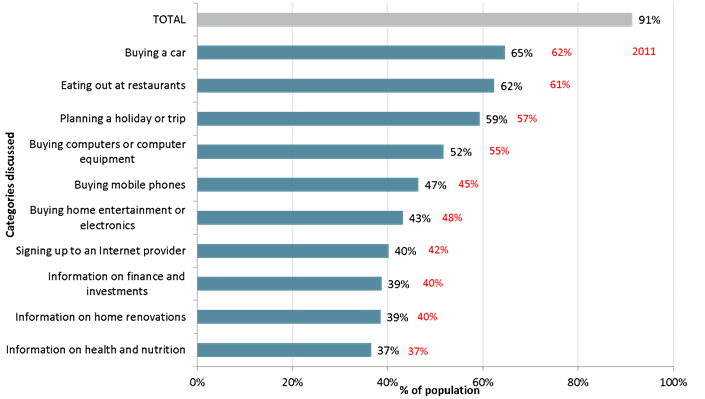Word of Mouth in 2018 – Australians still like to give and seek advice

New communications research from Roy Morgan shows over 91% of Australians aged 14+ have either sought advice from, or been the source of advice for their friends or family, with the most talked about topic being cars.
The most discussed topic amongst Australians aged 14+ is ‘buying a car’, with nearly two thirds (65%) of the population either playing the role of a trusted adviser (those whose advice has been sought by friends or family), an info seeker (those who go to friends/family for advice) or both. Eating out at restaurants is the second most discussed topic (62%) and planning a holiday or trip comes in third with 59%.
Less than half of the population seek or give advice on categories relating to mobile phones (47%), home entertainment or electronics (43%), signing up to an Internet provider (40%), finance and investments (39%), home renovations (39%), and health and nutrition (37%).
Top Ten Word of Mouth Categories Discussed by Australians

Source: Roy Morgan Single Source (Australia) 12 months to December 2017, n = 50,139, 12 months to September 2011, n = 52,119.
Base: Australians 14+.
In all categories, Australians tend to be more Info Seekers rather than Trusted Advisers. When buying a car, 52% of people have gone to their friends/family for advice compared to 27% who have provided advice to their friends/family.
Michele Levine, CEO, Roy Morgan, says:

“Marketers have always understood the importance and value of ‘Word of Mouth‘ to promote their products. This new research identifies the key drivers of this important form of communication. Roy Morgan unveils how much each topic is being discussed, and whose opinions are sought as ‘trusted advisers‘, and who are the ‘information seekers‘. In some areas, like eating out at a restaurant, there is a large percentage of people who regards themselves as both.
“Surprisingly, this new research shows ‘Word of Mouth’ is as important today even though information of all kinds is increasingly easy to get online. Even with all kinds of elaborate rating systems to score the value, accuracy, helpfulness, likeability or whatever, people still value advice from a ‘trusted advisor’ and people it seems still love to give advice.
“‘Trusted advisers’, those providing advice to friends and family are an important conduit to the rest of the population.
“Trusted advisers are not always first to try new products – indeed in some areas, trusted advisers are more likely the voice of caution, e.g. buying a car where trusted advisers tend to be older males; in others they are the voice of optimism, e.g. in make up where younger females tend to dominate the trusted adviser space.
“When it comes to giving advice, trusted advisers are still more likely to be male for computers or computer equipment, computer/console games, home entertainment or electronics, cars, and finance and investments to name a few. Women are still more likely to be trusted advisers for information on skincare and beauty products, fashion, decorating your home and most grocery and retail products.
“From a sociological perspective it is interesting that when it comes to seeking advice, men are below average across all categories. Women are far more open to receive information especially when it relates to information from other women on fashion and beauty products.”
For comments or more information please contact:
Roy Morgan - Enquiries
Office: +61 (03) 9224 5309
askroymorgan@roymorgan.com
Margin of Error
The margin of error to be allowed for in any estimate depends mainly on the number of interviews on which it is based. Margin of error gives indications of the likely range within which estimates would be 95% likely to fall, expressed as the number of percentage points above or below the actual estimate. Allowance for design effects (such as stratification and weighting) should be made as appropriate.
| Sample Size | Percentage Estimate |
| 40% – 60% | 25% or 75% | 10% or 90% | 5% or 95% | |
| 1,000 | ±3.0 | ±2.7 | ±1.9 | ±1.3 |
| 5,000 | ±1.4 | ±1.2 | ±0.8 | ±0.6 |
| 7,500 | ±1.1 | ±1.0 | ±0.7 | ±0.5 |
| 10,000 | ±1.0 | ±0.9 | ±0.6 | ±0.4 |
| 20,000 | ±0.7 | ±0.6 | ±0.4 | ±0.3 |
| 50,000 | ±0.4 | ±0.4 | ±0.3 | ±0.2 |
